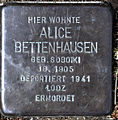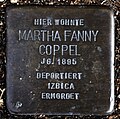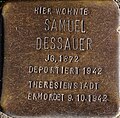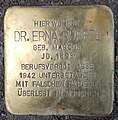Jews in Solingen
The history of the Jews in Solingen began in the 16th century. The first synagogue community was officially constituted in 1853, and the synagogue on Malteserstrasse was inaugurated in 1872. This was set on fire during the November pogroms on the night of November 10, 1938 by SA men and then torn down. At least 64 Solingen Jews were murdered during the Nazi era up to 1944. Today around 300 Jewish people live in Solingen, most of them from Soviet republics . The Solingen Jews are affiliated with the Wuppertal religious community .
history
From the 16th to the 20th century
The first Jews probably settled in Solingen in the middle of the 16th century. After 1710, other families moved in and formed a small community over the course of the 18th century. Most of them were small traders or butchers , a few traded in products made from the manufacture of blades . It was not until Napoleonic rule (1806-1813) that the handicraft privileges fell, so that they could participate in Solingen steel goods production and arms exports. From 1718 there was a Jewish burial place in Solingen Auf dem Clauberg (on Estherweg) , the area of which was expanded around 1900. The oldest surviving tombstone dates from 1820, the last burial took place in 1941.
From the second half of the 19th century, the number of Jewish residents grew due to immigration from surrounding villages. The end of the 1780s the congregation sat in a bought-in by Michel David and Samuel Coppel house on the corner Südwall / Ufergarten a prayer hall with a mikveh one that offered some 35 men square. Sometimes the community had problems paying a rabbi so that a member of the community had to take over his duties. The synagogue community of Solingen was officially constituted in 1853. It also comprised the Jewish families in the mayorries of Dorp , Gräfrath , Höhscheid , Merscheid and Wald ; from around 1880 more were added. The chairman of the community representatives was the entrepreneur Gustav Coppel , a grandson of Coppel Samuel, and the chairman of the board was his brother Arnold. In the summer of 1857 the synagogue communities Opladen and Solingen merged; At the end of the 1870s, the Opladen Jews broke away from Solingen and from then on formed the “Filialgemeinde Opladen”.
On March 8, 1872, the Solingen Jewish community inaugurated its new synagogue, a domed building on the corner of Malteserstrasse and Rechtsstrasse in the neo-Romanesque style, in the presence of dignitaries from the city and numerous residents, including a pageant . In addition to seating for 150 men, the building had space for over 80 women in the galleries; there was also a classroom and a teacher's apartment. The permanent employment of a teacher or cantor proved difficult because the position was poorly paid. It was not until the parish council lifted the obligation to be celibate in the mid-1880s that a teacher was found who served in the Solingen parish for decades.
Towards the end of the 19th century, more and more Jewish clothing stores opened in Solingen as in Ohligs . Of the more than 800 steel goods companies that existed in Solingen around 1930, 16 were owned by Jews; the company Alexander Coppel was one of the largest companies in the industry. Alexander's father Gustav Coppel (1830–1914) was politically active as a city councilor, district chairman of the National Liberal Party and president of the Chamber of Commerce ; he was also involved in charities. In 1906 the Coppel brothers initiated the Coppelstift , which began its work in the field of family welfare in 1912 and is today the oldest advice center for education in Germany. At the beginning of the 1930s, the majority of the city's Jews lived and worked in Ohligs, which was now incorporated into Solingen.
During the Nazi era
On the night of November 10, 1938, the Solingen synagogue was set on fire by members of the SA ; then drunk SA troops marched through the city, especially through the Ohligs, the devastated shops and homes of Jewish citizens and the Jewish cemetery with its chapel. On the same night the Jewish journalist Max Leven was mistreated in his Solingen apartment in front of his family by four men, including SS member Armin Ritter and the adjutant of the district leader Otto, Arthur Bolthausen , and then downright executed by Ritter with a pistol shot; his wife and two daughters were later murdered in camps. 32 Jewish men were in " protective custody taken" and most of them in the Dachau concentration camp were deported, many of them committed in the weeks that followed suicide .
At the beginning of 1939 the ruins of the synagogue were torn down. On February 25, 1939, the city administration charged the Jewish community 7,633.48 Reichsmarks for the demolition. A bunker was built on the site, now owned by the municipality, in 1944 . By the time the war began, most of the Jews still living in Solingen at the beginning of the Nazi era had emigrated .
The proportion of Jews in the total population of Solingen was always less than one percent. In 1804 there were 32 Jewish residents, in 1905 a high of 328 people was reached. In 1933, 219 Jews were resident in Solingen, of which 15 were still registered there in 1941. The few remaining Jewish people were deported to the Lodz ghetto at the end of 1941 or to Theresienstadt in 1942. 64 Solingen Jews are known by name who were victims of the Shoah , including the entrepreneur Alexander Coppel and his relatives. The names of the victims are listed on a plaque at the Jewish cemetery. Adolf Eichmann, born in Solingen, was one of the co-organizers of the nationwide “ Final Solution to the Jewish Question ” .
The 80-year-old doctor Emil Kronenberg was also deported to Theresienstadt in September 1944 along with six other Jews who had previously been protected by mixed marriages ; Kronenberg survived, returned to Solingen after the war and, as before, was politically and socially active in the city. The pediatrician Erna Rüppel survived the Nazi era with false papers in various hiding places - including in Munich - and opened a practice again in Solingen after the end of the war.
Since the war
In the years after the end of the war, initially only a few Jews lived in Solingen again; At the end of the 1960s there were said to have been about ten people. In 2010, around 300 people of Jewish faith lived in the city, the majority of whom came from former Soviet republics. In Solingen there is no longer an independent synagogue community; it is affiliated with the Wuppertal religious community.
memory
A plaque attached by the city administration in 1979 to the bunker in Malteserstraße reminds of the former location of the Solingen synagogue. Another memorial plaque attached to the bunker in 1998 commemorates all victims of the Nazi tyranny. Since 2012 there has also been a bronze relief by the sculptor Henryk Dywan , which shows the synagogue and which goes back to an initiative of students from the Schwertstrasse high school .
On the occasion of the 80th anniversary of the destruction of the synagogue by the National Socialists, the Solinger Kunstverein, in cooperation with the Cologne Art Academy for Media (KHM), commemorated this event in 2018 ; The initiator was the Solingen artist Andreas Schäfer . Works were shown that dealt artistically with the Jewish community, the history of its destruction and the current culture of remembrance.
Stumbling blocks in Solingen (selection)
Web links
Individual evidence
- ↑ a b c d e f History of the Jewish community. In: juedischer-friedhof-solingen.de. Retrieved June 18, 2019 .
- ↑ The Jewish cemetery on Estherweg. In: solingen.de. January 1, 2018, accessed June 18, 2019 .
- ↑ a b c d e f g h i j k l Solingen (North Rhine-Westphalia). In: From the history of the Jewish communities in the German-speaking area. Retrieved June 17, 2019 .
- ↑ Coppel Samuel's children took Coppel as a family name.
- ^ Leven, Max - Leven, Emmi - Leven, Heinz - Leven, Hannah - Leven, Anita. In: solingen.de. Retrieved June 17, 2019 .
- ↑ a b Ralf Rogge, Armin Schulte, Kerstin Warncke: Solingen. Big city years 1929-2004 . Edited by the Solingen City Archives and the Solinger Tageblatt . Wartberg-Verlag, 2004, ISBN 3-8313-1459-4 . P. 6.
- ↑ Coppel, Dr. Alexander. In: solingen.de. August 5, 1942, accessed June 18, 2019 .
- ↑ Horst Sassin : Survival in the Underground. The pediatrician Dr. Erna Rüppel (1895–1970). In: Die Heimat Nr. 26. Retrieved on June 18, 2019 . (pdf)
- ↑ Philipp Müller / Max Püttbach: Pogrom Night is a reminder for today. In: solinger-tageblatt.de. November 10, 2018, accessed June 18, 2019 .










